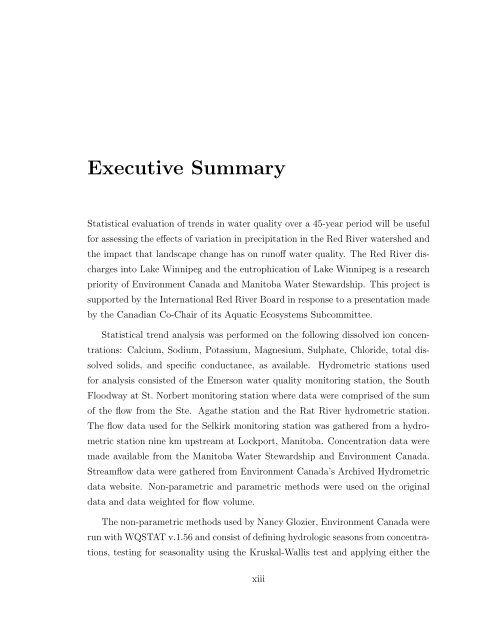Statistical Analysis of Trends in the Red River Over a 45 Year Period
Statistical Analysis of Trends in the Red River Over a 45 Year Period
Statistical Analysis of Trends in the Red River Over a 45 Year Period
Create successful ePaper yourself
Turn your PDF publications into a flip-book with our unique Google optimized e-Paper software.
Executive Summary<br />
<strong>Statistical</strong> evaluation <strong>of</strong> trends <strong>in</strong> water quality over a <strong>45</strong>-year period will be useful<br />
for assess<strong>in</strong>g <strong>the</strong> effects <strong>of</strong> variation <strong>in</strong> precipitation <strong>in</strong> <strong>the</strong> <strong>Red</strong> <strong>River</strong> watershed and<br />
<strong>the</strong> impact that landscape change has on run<strong>of</strong>f water quality. The <strong>Red</strong> <strong>River</strong> discharges<br />
<strong>in</strong>to Lake W<strong>in</strong>nipeg and <strong>the</strong> eutrophication <strong>of</strong> Lake W<strong>in</strong>nipeg is a research<br />
priority <strong>of</strong> Environment Canada and Manitoba Water Stewardship. This project is<br />
supported by <strong>the</strong> International <strong>Red</strong> <strong>River</strong> Board <strong>in</strong> response to a presentation made<br />
by <strong>the</strong> Canadian Co-Chair <strong>of</strong> its Aquatic Ecosystems Subcommittee.<br />
<strong>Statistical</strong> trend analysis was performed on <strong>the</strong> follow<strong>in</strong>g dissolved ion concentrations:<br />
Calcium, Sodium, Potassium, Magnesium, Sulphate, Chloride, total dissolved<br />
solids, and specific conductance, as available. Hydrometric stations used<br />
for analysis consisted <strong>of</strong> <strong>the</strong> Emerson water quality monitor<strong>in</strong>g station, <strong>the</strong> South<br />
Floodway at St. Norbert monitor<strong>in</strong>g station where data were comprised <strong>of</strong> <strong>the</strong> sum<br />
<strong>of</strong> <strong>the</strong> flow from <strong>the</strong> Ste. Aga<strong>the</strong> station and <strong>the</strong> Rat <strong>River</strong> hydrometric station.<br />
The flow data used for <strong>the</strong> Selkirk monitor<strong>in</strong>g station was ga<strong>the</strong>red from a hydrometric<br />
station n<strong>in</strong>e km upstream at Lockport, Manitoba. Concentration data were<br />
made available from <strong>the</strong> Manitoba Water Stewardship and Environment Canada.<br />
Streamflow data were ga<strong>the</strong>red from Environment Canada’s Archived Hydrometric<br />
data website. Non-parametric and parametric methods were used on <strong>the</strong> orig<strong>in</strong>al<br />
data and data weighted for flow volume.<br />
The non-parametric methods used by Nancy Glozier, Environment Canada were<br />
run with WQSTAT v.1.56 and consist <strong>of</strong> def<strong>in</strong><strong>in</strong>g hydrologic seasons from concentrations,<br />
test<strong>in</strong>g for seasonality us<strong>in</strong>g <strong>the</strong> Kruskal-Wallis test and apply<strong>in</strong>g ei<strong>the</strong>r <strong>the</strong><br />
xiii
















